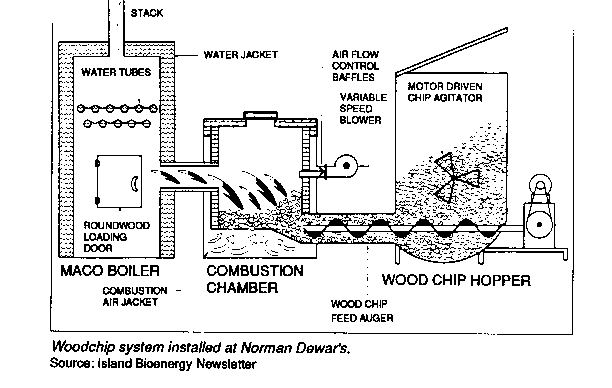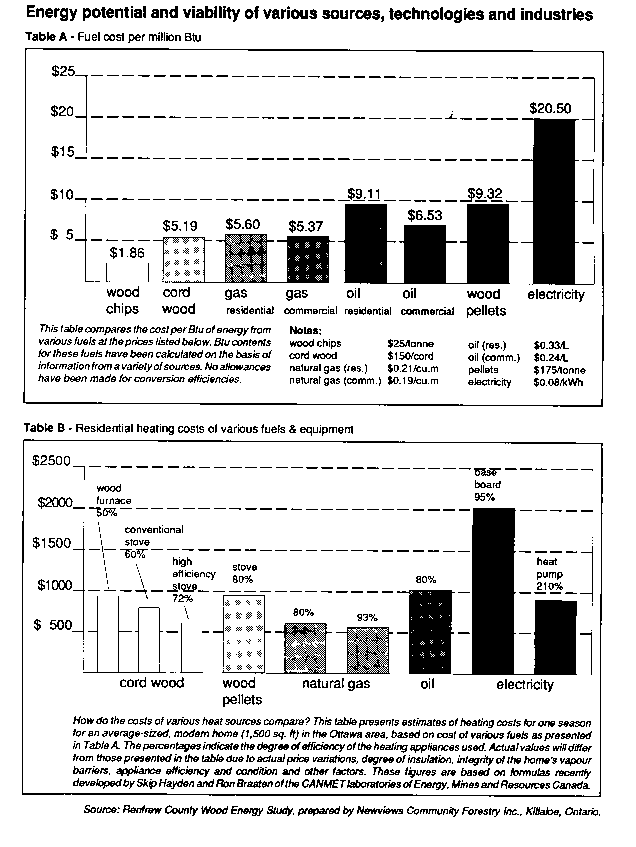
Sustainable Farming Index | Virtual Library | Magazine Rack
Search
| Ecological Solutions Roundtable
by Anne McCallum
Clean . . . renewable . . . indigenous . . . three words which describe a heating fuel that is becoming increasingly popular among farmers and greenhouse operators in Prince Edward Island. Presently, over 60 food producers and small businesses are using bio-mass fuel in the form of woodchips or sawdust to heat their barns, machinery sheds, workshops and homes.
Some farmers are producing their own chips from non-merchantable products produced during silviculture operations on their farm woodlots. Others are using waste wood from local sawmills. Both types of fuel perform well in automated, highly efficient bio-mass combustion systems that reduce energy costs while improving farm productivity.
Prince Edward Island is a North American leader in the development and utilization of automated woodchip heating technologies. These efforts began in 1977 and have progressed slowly over 15 years. Today, there are two woodchip district heating systems in Charlottetown and 20 industrial class woodchip systems operating in schools and hospitals. About 60 small commercial systems in the 75-160 kW capacity range have been installed on farms and other small businesses on the Island.
The number of small commercial woodchip systems is growing, partly due to financial incentives provided by Energy, Mines and Resources through the Canada-Prince Edward Island Cooperation Agreement on Alternative Energy and Energy Efficiency. Under the Energy Diversity Program, farms and businesses receive a 50% subsidy for bio-mass combustion equipment and installation costs.
Another key factor has been the development of reliable, locally-built systems that are simple to operate and easy to maintain. Until recently, woodchip technology had to be imported from Scandinavia where it was originally developed. High freight costs made the equipment expensive and replacement parts were difficult to obtain.
Since 1988 Vince Court of Covehead, PEI has been supplying Islanders with alternative systems that he designs and builds under the trade name Bio-Blast.
"I retained some of the basic concepts of the Scandinavian units but introduced design improvements," explains Court. "There have been many changes over the last few years and our present units are performing better and lasting longer than the Scandinavian ones."
Tests conducted by Energy Mines and Resources last year indicate that Bio-Blast systems have a high energy conversion efficiency and very low particulate emissions. The 130 kW unit, for example, had a measured CSA standard B415 conversion efficiency of 70%. With medium moisture chips and sawdust, the measured particulate emissions were close to 0.02g/MJ. This is about 4 times lower than the proposed limit for such systems.
Most recent woodchip installations in PEI have used Bio-Blast systems. One such system is installed at Norman Dewar's hog farm in Springfield West, near O'Leary. Dewar has a 100 sow farrow-to-finish operation. His 130 kW woodchip system, which he installed last February, heats the sow barn, nursery, farrowing barn, office and storage building. It also produces enough hot water to supply a 4 gal/min. pressure washer as well as hot water for personal use in the barn.
"I've got nothing but praise for the system," says Dewar. "Anything that has gone wrong has been pretty minor. The burner has never gone out and I haven't had to put a match to it since we started."
Dewar's woodchip supply comes from a small sawmill about 15 kilometres away. He buys chips produced from waste slabs for $25 a tonne delivered, using about 120 tonnes a year. The chips are stored in a 24' x 20' section of the building which also houses the heating system and Dewar loads the chips into the fuel bin using the bucket of the front end loader. He loads it twice a day, morning and afternoon.
"It doesn't take much time, I don't think I even spend 20 minutes a day loading the chips. And it takes me less that 5 minutes to knock the ash down in the morning," he explains.
It costs Dewar a little over $3000 a year for woodchips. That's slightly more than he was paying for oil but he is now able to heat a much larger area. The extra heat is good for his hogs, especially when temperatures plummet below -20o Celsius as they have been doing for long periods this winter, and he believes that improved feed conversion rates, as well as air quality, are connected to the heating system.
"I'm a minimal disease multiplier breeder so air quality is very important in terms of maintaining low rhinitis scores," he explains.
Eric Weeks, a dairy farmer from Pleasant Valley, also heats with woodchips. He uses one of the earlier 130 kW Bio-Blast burners to heat both his machinery shop and the farm home. It also supplies all the hot water he needs for the dairy barn.
Instead of buying woodchips, however, Weeks produces his own from a Bruks 982 chipper which runs off the PTO of his 70 hp farm tractor.
Producing his own chips is practical for Weeks because he owns 150 acres of woodland which is actively managed under a provincial forest management program. He skids full trees from thinning to the edge of the field and the large diameter wood is cut up for firewood. Small diameter limbs, tops and dead wood that cannot be sold as firewood are chipped for farm use without much additional labour or expense.
Aside from the benefits to individual farm operators, the use of bio-mass energy for heating purposes has a number of additional advantages, both for the environment and for the local economy, says Bruce McCallum of Ensight Consulting, a bio-energy and forestry consulting firm in Hunter River. McCallum, who is a woodlot owner himself, has been a proponent of woodchip technology for over 10 years.
"Bio-mass energy is a very clean, renewable resource. To the extent that fossil fuels are being displaced, it also lessens the greenhouse effect. However, the most significant benefits of bio-energy use are economic," he says.
In addition to making better use of existing equipment and labour, as well as reducing heating costs, the monies saved also have a spin-off effect. McCallum notes that in PEI approximately 90 cents out of every dollar spent on heating oil leaves the province, whereas 90 cents of every dollar spent on woodchips produced by woodlot owners remains within the local economy.
A lack of access to low cost natural gas and electricity, a long tradition of wood heating in rural areas and active government support have pushed Prince Edward Island into the forefront of biomass technology development and utilization. The success experienced in PEI may well encourage more farmers and rural people across Canada, where there are forests or where there is a consistent supply of sawmill waste, to examine the potential benefits of using their local bio-mass energy resources.
Every heating system is a little different depending on the physical lay-out of farm buildings and the heat load involved. However, a typical woodchip system includes the following components:
A fuel reserve is a bin or building where wood fuel is stored. Most fuel reserves in farm systems are simply conventional farm buildings such as pole barns or steel structures.
The fuel metering bin is a bin or hopper that stores enough fuel for at least a day. They range in size from 3 to 6 cubic metres.
The fuel feed system automatically extracts fuel from the metering bin and feeds it into the combustion chamber.
The combustion chamber is a small firebrick lined chamber where the fuel is burned. Combustion takes place on a grate in the chamber and in a small firebrick tunnel that connects the burner to the heat exchanger. Fuel is fed into the combustion chamber by an auger. A small fan directs pre-heated primary combustion air below the grate and a small amount of secondary combustion air above the grate.
The heat exchanger is a hot water boiler that extracts heat from the spent combustion gases. Round wood or straw (and dead animals) can also be burned in most boilers.
The heat distribution system transports heat from the boiler via pipes to radiation systems in the buildings where it is needed.


Copyright © 1993 REAP Canada
Reprinted with permission. All rights reserved.
Info Request | Services | Become EAP Member | Site Map
Give us your comments about the EAP site
Ecological Agriculture Projects, McGill University (Macdonald
Campus),
Ste-Anne-de-Bellevue, QC, H9X 3V9 Canada
Telephone:
(514)-398-7771
Fax:
(514)-398-7621
Email: info@eap.mcgill.ca
To report problems or otherwise comment on the structure of this site, send mail to the Webmaster